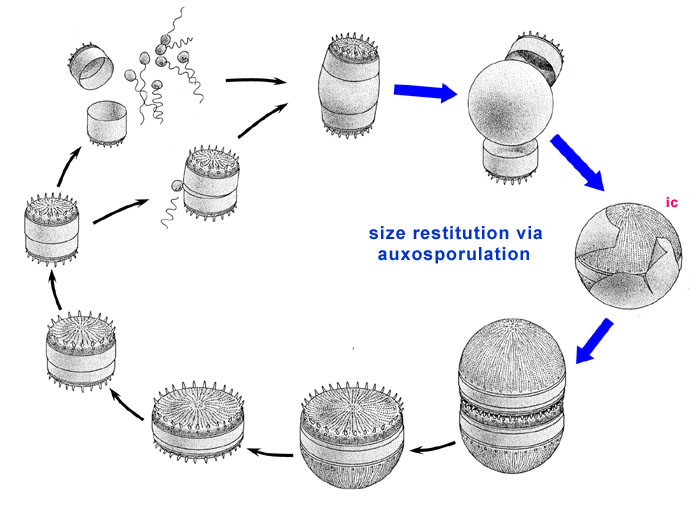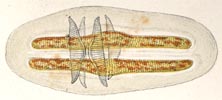
Life cycle of a centric diatom. III

Size restitution
Size is restored in diatoms through a special cell called the 'auxospore' (meaning growth- or growing spore). This is not a spore in the normal sense: it is not a dispersal unit like the spores of mosses or ferns or mushrooms, nor is it not a resistant or dormant stage like the zygospores of the green algae Spirogyra or Zygnema. Instead, its function is to regenerate the maximum size and characteristic shape of that particular diatom.
The auxospore is usually (but not invariably) a zygote and hence it is almost always diploid. It is not naked but possesses a special organic wall, or a composite wall composed of organic and silica elements. The growth of the auxospore can be isodiametric, as in the illustration, or it may be constrained by harder, less elastic sections of its wall, producing bipolar or multipolar shapes.
Once it has finished expanding, the auxospore forms a new frustule inside to form the 'initial cell' (ic) of the next generation. Because it is formed within the auxospore, rather than within another vegetative cell, the initial cell has a modified morphology relative to the vegetative cells produced subsequently.
The illustrations are modified by DG Mann from the originals used by Mann in Round et al. (1990, fig. 55)
References
Chepurnov, V.A., Mann, D.G., Sabbe, K. & Vyverman, W. (2004). Experimental studies on sexual reproduction in diatoms. International Review of Cytology 237: 91-154.
Round, F.E., Crawford, R.M. & Mann, D.G. (1990). The diatoms. Biology and morphology of the genera. Cambridge University Press, Cambridge.

 This site is hosted by the Royal Botanic
Garden Edinburgh.
This site is hosted by the Royal Botanic
Garden Edinburgh.